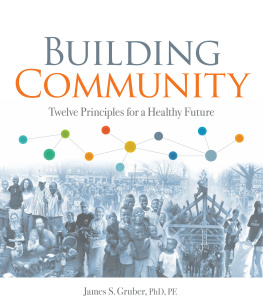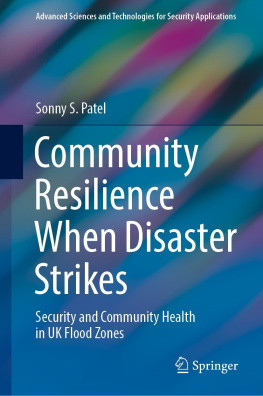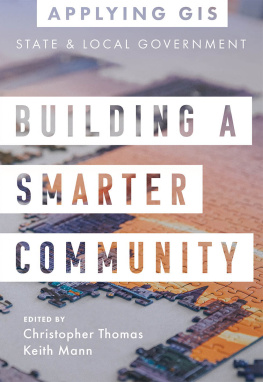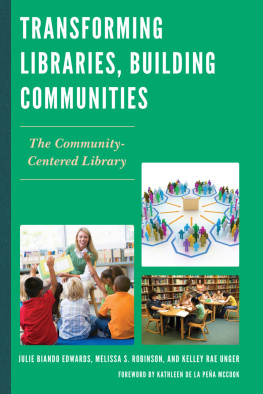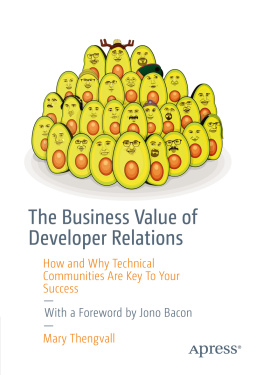Contents
Guide

ADVANCE PRAISE FOR
Building Community
Building Community is a welcome contribution to the world of sustainable community development. Jim Gruber has assembled a guide to essential research, case studies and tools to help citizens and community leaders address fundamental issues of participatory democracy. This vital resource for community building illuminates a path for reconstructing formidable problems into tangible solutions.
Dr. Mark Roseland, professor and director, School of Community Resources and
Development, Watts College of Public Service and Community Solutions,
Arizona State University, author, Toward Sustainable Communities
This book pulls together decades of invaluable field work to illuminate essential principles of practice for transforming intractable problems into challenges that together we can solve. This is crucial reading for all who feel compelled to lead, not because they have authority, but simply because they care deeply about their community and world.
Ronald A. Heifetz, MD, founder, Center for Public Leadership,
Harvard Kennedy School, author, Leadership Without Easy Answers,
co-author, Leadership on the Line
At a time when we are confronted daily with the limitations of national and global institutions to address the pressing challenges facing our planet, this engaging book reminds us of the vital role that strong local communities play in creating a resilient future. Gruber considers the challenging questionhow can communities move from surviving to thriving?and answers it in terms that are at once inspiring and pragmatic. Framed around 12 principles and illustrated with experience from communities in regions as diverse as rural New England, Andean South America, West Africa, and the Baltics, Building Community provides us with clear, approachable guidance on how to move in that direction.
Jessica Brown, executive director,
New England Biolabs Foundation
Building Community is a remarkable guidebook on how to get controversial but critically important things done at the local level. It is also a highly insightful but down-to-earth leadership manual for individuals committed to making a contribution at the community level. As a decades-long practitioner of American democracy promotion abroad with a strong interest in comparative political cultures and in nurturing effective leadership, I was stunned by the extraordinary range of issues, countries, and situations addressed in this books rich set of case studies. It is a must read for those seeking to make a lasting difference at the local level, while at the same time strengthening the building blocks of their democracy.
Ambassador Adrian A. Basora (USFS, Ret.),
principal author, Does Democracy Matter?
Jim Gruber shares the lessons of a valuable career helping local communities learn how to solve their environmental and sustainability challenges. He identifies guiding principles that show how collaborative approaches succeed in communities across the globe. I am so impressed that I gave a copy to my mayor!
Dr. David Blockstein, senior adviser,
Association for Environmental Studies and Sciences (AESS)
While the leadership principles presented in Building Community are used in addressing environmental issues, they would be valuable for problem solving relating to any persistent, systemic problem facing a community. Gruber highlights how these communities not only worked to resolve seemingly intractable problems, but also built community muscle. Make room on your bookshelf for this substantive work.
David Mathews, president, Kettering Foundation
James Gruber has captured the essence of what it means to collaborate with a community of stakeholders in order to achieve sustainability. His how to blueprint contained in the twelve principles coupled with his insightful analysis of specific case studies, makes this a must read for students, academics, and practitioners alike.
John MacLean, retired Keene New Hampshire city manager,
senior consultant, MRI
As we move through this century, functional communities will become critical for personal wellbeing. In this very user-friendly guide, Jim Gruber clearly maps out how people can create inclusive, vital communities. Packed with case studies and very helpful hints, this is a gem of a resource for anyone wanting to strengthen their own community.
Tom Wessels, author, Granite, Fire, and Fog,
Reading the Forested Landscape, and The Myth of Progress,
faculty emeritus, Antioch University
Gandhi repeatedly said that to defeat systems of domination like British imperialism you need militant forms of nonviolent resistance, but to build just, thriving, and sustainable communities you need to organize many local, collaborative, inclusive, and constructive community initiatives and institutions. James Grubers new book powerfully fleshes out this second path for community leaders todaywith relevant research, stories from around the world, and hard-won wisdom distilled from Grubers many years of practical experience.
Dr. Steve Chase, International Center on Nonviolent Conflict
James Gruber, a highly experienced civil engineer, town manager, university faculty member, and consultant presents rich case study examples of successful community initiatives and projects that have made positive impacts nationally and internationally, countering the obstacles that lead to continued apathy and despair. Gruber provides guiding principles for essential leadership and building citizen engagement. More importantly, he provides a powerful antidote to withdrawal and isolation, while giving a gift of inspiration and hope.
James H. Craiglow, President Emeritus,
Antioch University New England
Building Community is a roadmap and blueprint for working with local people in a collaborative manner so that everyone can make a significant contribution towards sustainable societal transformation.
Dr. Esther Adhiambo Obonyo, Associate Professor of Engineering Design and
Architectural Engineering, director, Global Building Network,
a partnership with UNECE
To Patience
In deep appreciation of your love,
brilliance, caring, and support that
made this book possible.

BUILDING
COMMUNITY
Twelve Principles for a Healthy Future
James S. Gruber, PhD, PE
Copyright 2020 by James S. Gruber
All rights reserved.
Cover design by Diane McIntosh
All photos supplied by James S. Gruber
Printed in Canada. First printing May, 2020.
Inquiries regarding requests to reprint all or part of Building Community
should be addressed to New Society Publishers at the address below.
To order directly from the publishers, please call toll-free (North America)
1-800-567-6772, or order online at www.newsociety.com
Any other inquiries can be directed by mail to:
New Society Publishers
P.O. Box 189, Gabriola Island, BC V0R 1X0, Canada
(250) 247-9737
LIBRARY AND ARCHIVES CANADA CATALOGUING IN PUBLICATION
Title: Building community : twelve principles for a healthy future /
James S. Gruber, PhD, PE.
Names: Gruber, James S., 1950 author.
Description: Includes bibliographical references and index.

